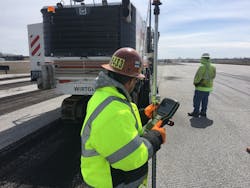Distracted driving due to the use of cell phones and other mobile devices is an ongoing problem on the road, but the stakes can be even higher for operators on a job site, where the sheer tonnage of the equipment being operated carries a higher risk for serious injury and death.
On-road, motorists have a fighting chance—they have the benefit of at least being somewhat protected in their own vehicles—workers walking around job sites don’t have any metal around them.
Although many companies have their own rules about cell phone and mobile device use on the job site, and OSHA has an actual regulation in place for crane operators, enforcement can be difficult. No foreman or safety director can see everything.
Enter Truce Software with its Contextual Mobile Device Management platform (CMDM).
Originally designed to disallow distracted driving and counter workers’ cell phone addictions in the name of productivity, the product has entered the realm of safety on the construction or industrial job site.
The theory behind CMDM is that companies can “maximize the mobile device experience based on the zone where the employee is working, whether that’s traveling in the field, reporting to a job site, or sitting behind a desk at the office or in a meeting room.”
Based on the zone, certain apps on an individual’s device are served up and made available depending on his or her unique situation, location, and time.
Here’s how it works: CMDM software resides on an employee’s mobile device, and intelligently “follows” that individual and identifies the zone or environment where they are working based on contextual indicators. Once the context is identified, apps and functionality on that person’s device are temporarily activated or deactivated according to the employer’s mobile-device usage policy to enable optimal engagement, safety, and productivity in the specific setting, according to Truce.
The employer and the worker will always know that device usage is compliant with company policy.
“Truce is more like a safety switch for mobile devices,” says Joe Boyle, the company’s CEO. “It uses that contextual awareness, meaning it recognizes where and how a mobile device is being used, to automatically enforce policies in hazardous or risky work environments, including driving a commercial vehicle or operating heavy equipment.”
Naturally, contractors and workers may have privacy concerns with employers, and a third-party company, having control over where and when apps on their phones can be accessed It's a case of “If they have this much access to my apps, what else can they see?”
“We respect the employee’s privacy,” Boyle says. “[The software] never collects or stores personal data such as credit card information, passwords, or photos. Call details, texting information, and emails are not accessed or read. Additionally, information is never collected on what apps are being used or what the apps are being used for.”
Boyle stresses that employers address their employees’ privacy concerns about the system up front. “When communicating the rollout of Truce, it's important to remind employees why a mobile device usage policy exists in the first place—to protect their safety and well being, as well as that of the business and communities they serve,” he says.
“Adopting Truce in the workplace is a change for the entire organization, not just for the employees that will be using the app. How people inside the organization work and communicate will be impacted for the better,” Boyle says.
For their part of the privacy issue, employers are limited on what they can see and use for potential discipline. For example, they won’t be able to see who tries to access restricted apps, or how often they may try.
“Truce doesn’t track what apps employees attempt to access or who they attempt to call,” Boyle explains. “When Truce is active, the company’s policy is enforced, eliminating any opportunity for the employee to access apps or features that are prohibited.”
Boyle says the Truce Management Console is used to manage enforcement of a company’s mobile device usage policies across its employee base. It provides insights on the status of every employee subscribed to the platform, such as whether or not the app has been uploaded and is being used correctly.
“The dashboard function allows the administrator to drill down into data-specific or managed sessions,” Boyle says. “Those are the times when the app is in use and the policy is being enforced. Metrics available on the dashboard, including how many managed sessions occurred and what type—such as driving a vehicle or operating a forklift—as well as how much time was spent in each session, helps managers with identifying opportunities for productivity improvements while also providing assurance of policy enforcement in higher-risk work zones.”
Truce is designed to work on both iOS and Android mobile operating platforms, independent of the device manufacturer or mobile network provider.
Source: Truce Software





